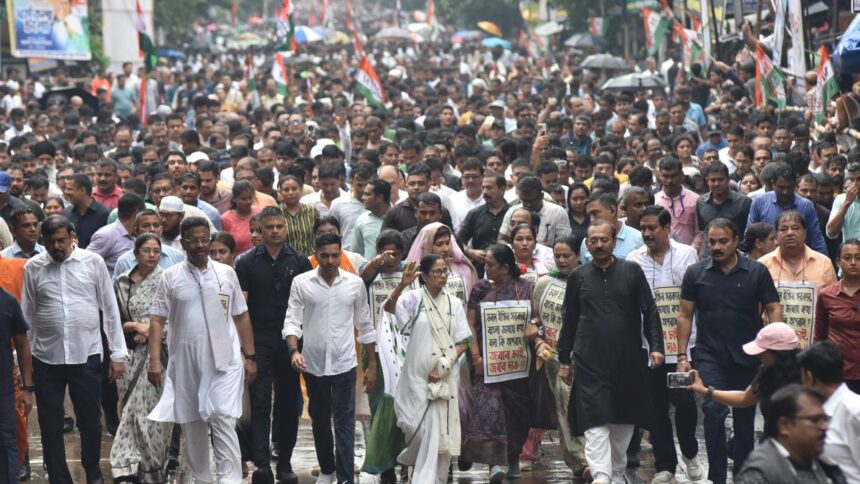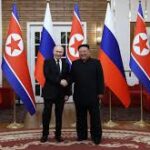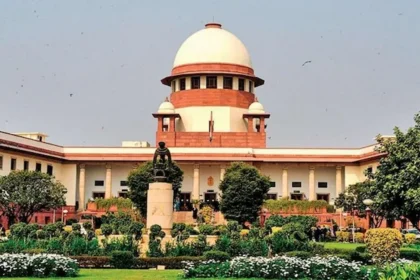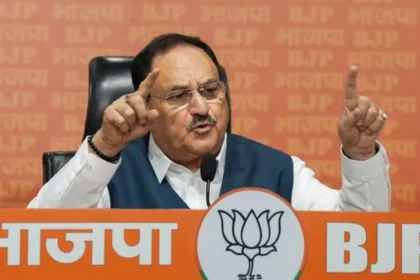A March Through History — Mamata’s Kolkata Protest and the Language of Resistance
In the sweltering lanes of central Kolkata, where the legacy of protest pulses through the air like the rhythm of Rabindra Sangeet, West Bengal Chief Minister Mamata Banerjee led a march that was as much about politics as it was about identity. The protest, held in July 2025, wasn’t just another addition to the state’s long list of political mobilizations. It was a message wrapped in symbolism, walking on foot through the city’s historic streets—a direct challenge to the BJP-led Central government’s alleged marginalization of Bengali-speaking communities.
Surrounded by thousands of supporters, Mamata walked with visible determination, her voice echoing through microphones as she accused the Centre of systematically targeting Bengalis under the guise of governance. The slogans were clear, emotional, and piercing: “Bengal will not bow down.” What began as a political statement quickly grew into a cultural resistance.
Language as Identity: The Bengali Soul
For decades, language has been the soul of Bengal’s political resistance. From the fiery days of the independence movement to the cultural revolutions of the 1970s, the Bengali language has always stood at the heart of mass mobilization. Mamata’s march invoked that legacy—not just to highlight alleged discrimination, but to reassert the pride of the Bengali-speaking populace.
The accusation was simple, yet powerful: that the BJP’s policies and political tone had become hostile towards Bengalis, especially outside West Bengal. She cited recent events in Assam, Delhi, and even Maharashtra, where Bengali speakers reportedly faced bureaucratic hurdles and social alienation. “If you continue to harass Bengalis,” Mamata warned, “prepare for a political backlash the likes of which you have never seen.”
Political Messaging or Populist Performance?
Critics of Mamata Banerjee argue that the protest was more about optics than impact. With upcoming state elections in mind and the BJP pushing hard to make electoral inroads in Bengal, this protest conveniently positioned her as both protector and provocateur. Detractors questioned whether the BJP’s actions truly amounted to a coordinated attack on Bengalis or whether Mamata was inflating isolated incidents into a full-blown narrative of persecution.
However, supporters dismissed this cynicism. They point to a pattern—bureaucratic apathy in other states, disproportionate crackdowns on Bengali communities, and a national political discourse that often sidelines regional identities. For them, this protest wasn’t performative—it was overdue.
Echoes of the Past: From Language Movements to Modern Mobilization
To understand the full emotional weight of the protest, one must view it against the backdrop of Bengal’s historical struggles. The language movement in Dhaka (then East Pakistan) in the 1950s, where people died defending their right to speak Bengali, remains etched into Bengali consciousness—even in West Bengal. Mamata’s march tapped into that historical vein, aligning today’s administrative friction with the past’s existential battles over language and identity.
In her speech at the rally’s endpoint, Mamata declared, “They want to erase our culture, erase our language. We won’t let them.” It was more than political rhetoric—it was a call to protect the intangible heritage of Bengal, which she believes is under siege.
If Mamata Banerjee’s protest march in Kolkata signaled a fiery assertion of cultural pride, the BJP’s response was no less calculated. Within hours of her sharp warnings, party leaders at both the state and national levels issued counter-statements. Their tone was unyielding, their message unequivocal: “Mamata is manufacturing outrage for political gain.”
The BJP’s Counter-Narrative: Deflection or Defense?
According to the BJP, there is no coordinated campaign to harass Bengali-speaking citizens. Party spokespersons framed Mamata’s accusations as a classic case of political deflection—an attempt to divert attention from governance failures in West Bengal by inciting cultural victimhood. “This is fear-mongering disguised as activism,” said one senior BJP leader. “The BJP respects all Indian languages and cultures. We reject her politics of division.”
The party’s state unit also took to social media, launching digital campaigns to portray Mamata as a leader who uses identity politics to shield herself from real scrutiny: unemployment, infrastructure decay, and law-and-order challenges in Bengal. The BJP emphasized that its national outreach was focused on “inclusive governance,” not linguistic suppression.
Election Chessboard: Preparing for 2026
Both camps are acutely aware that this battle of narratives is about far more than language or protest—it’s about power. The 2026 West Bengal Assembly elections loom large, and each public act is being weighed, measured, and spun in the shadow of the coming contest. While Mamata Banerjee is preparing to defend her turf, the BJP is aggressively working to breach it.
The BJP’s electoral strategy, insiders say, involves painting Mamata as parochial and inward-looking, while projecting itself as the party of modern governance and national unity. By portraying Mamata’s protest as a regressive appeal to identity over development, the BJP seeks to energize middle-class voters and Bengali-speaking Hindus who are skeptical of constant confrontation with the Centre.
On the other hand, Mamata’s Trinamool Congress is doubling down on its regional appeal, particularly among rural voters, minorities, and the working class—sections that historically resonate with themes of cultural pride and local identity.
Beyond Politics: The Emotional Undercurrents
Despite the political jockeying, the emotional resonance of Mamata’s protest cannot be dismissed outright. In a state where language, literature, and legacy are deeply woven into the public psyche, even subtle threats to cultural pride can create political tremors.
For many ordinary Bengalis, especially those living in other states, Mamata’s march served as a moment of representation. Bengali-speaking citizens in Maharashtra, Delhi, and parts of the Northeast have long complained of subtle forms of discrimination—from delayed government documentation to public service indifference. While these issues are not always visible in policy documents, they accumulate as lived experience. And when a political leader articulates these frustrations, even if for electoral gains, it resonates.
In interviews conducted with march participants, a common sentiment emerged: “We are not against India or Hindi. But why should we be made to feel less Indian because we speak Bengali?”
The National Implications: A Delicate Federal Fabric
Mamata Banerjee’s Kolkata protest and the BJP’s reaction highlight a deeper tension at the heart of Indian federalism: the struggle between cultural autonomy and national integration. As India grows more centralized under a strong central leadership model, regional leaders often find themselves needing to assert their local identity to preserve political relevance.
This tension is not new. From the Dravidian movement in Tamil Nadu to Shiv Sena’s Marathi pride campaigns in Maharashtra, regional assertions have long coexisted with national politics. Mamata’s protest fits within this tradition, but with a unique emotional charge rooted in the Bengali linguistic ethos.
While politicians sparred across microphones and press releases, the streets of Bengal began telling their own story. Mamata Banerjee’s protest wasn’t confined to the high-voltage corridors of Kolkata—it had sparked a chain reaction across the state, and the ripple effect was unmistakable.
In districts like Howrah, Nadia, Cooch Behar, and North 24 Parganas, smaller rallies, solidarity marches, and student gatherings were seen in the days following the Kolkata protest. Though not all were officially organized by the Trinamool Congress, they carried the unmistakable spirit of cultural defense and linguistic pride. The emotional narrative had trickled down from the stage to the sidewalk.
Voices From the Ground: Identity, Fear, and Defiance
To understand the impact of Mamata’s protest on everyday Bengalis, one must walk beyond the headlines. In a small tea stall outside Bardhaman, an elderly man, reading Anandabazar Patrika, remarked: “They call her dramatic, but at least she speaks our language in Delhi. Who else is doing that?”
For young students in urban Kolkata, however, the mood was more complex. A group of Jadavpur University undergraduates voiced concern over Mamata’s methods but acknowledged the larger issue: “We don’t support all of her politics,” said one student activist, “but she’s not wrong about the way Bengalis are often mocked or ignored outside West Bengal. It’s real.”
The working-class population—especially Bengali-speaking migrants in Delhi, Pune, Bengaluru—seemed most deeply affected. On WhatsApp groups and Facebook pages dedicated to migrant communities, discussions took off about harassment cases, language-based bias in public offices, and the sense of alienation experienced by Bengali speakers in other parts of India.
These are not always dramatic incidents. Often, they are subtle: being told to “speak in Hindi,” being denied address proofs due to origin-state suspicion, or being left behind in public queues due to misunderstanding of local language. These micro-aggressions, when named by a political figure like Mamata, give voice to otherwise private frustrations.
Media Influence: Divergent Narratives Across Screens
As with most political movements today, Mamata Banerjee’s protest gained momentum or lost credibility depending on which media platform one followed. Bengali-language media broadly supported the protest, framing it as a cultural assertion. Channels like ABP Ananda, Zee 24 Ghanta, and News18 Bangla highlighted Mamata’s historical invocations and presented the protest as a response to “Hindi hegemony” and rising centralization.
In contrast, national English and Hindi news channels, particularly those aligned with the BJP’s worldview, labeled the protest as “divisive,” “regionalist,” or “desperate.” Prominent anchors questioned Mamata’s data, accusing her of inflaming identity politics for electoral benefit.
Social media was its own battlefield. On X (formerly Twitter), hashtags like #MamataForBengalis and #StopHindiImposition trended alongside critical ones like #MamataDividesIndia and #TMCDrama. The information ecosystem, divided and algorithmically amplified, reflected the growing national fracture over cultural federalism.
Return of Street Politics: Bengal’s Timeless Theatre
Bengal’s streets have long served as arenas for ideological confrontation. From the Left Front era’s iconic red rallies to student movements like the one after the Park Street rape case, Kolkata in particular has never shied away from hitting the road in protest.
Mamata Banerjee, once a solitary protestor with a poster in hand during her Congress Youth days, has always known how to marshal street power. It’s not just political for her—it’s visceral. Unlike many politicians who outsource mobilization, Mamata walks the streets herself, often barefoot, arms raised, slogans echoing. For her, the pavement is power.
This time, the symbolism was profound. Walking through Esplanade—historically the site of freedom protests, labor rallies, and cultural parades—Mamata didn’t just mobilize a crowd; she mobilized memory.
Political scientist Dr. Debajyoti Ray notes, “Her protest wasn’t merely a reaction. It was pre-emptive. She knows the BJP is preparing to penetrate deeper into the Bengali electorate, and she’s positioning herself as the sole authentic defender of Bengali pride. It’s not just politics—it’s cultural strategy.”
What began as a single protest march through the heart of Kolkata has now grown into a larger debate—one that strikes at the very core of India’s political structure. Mamata Banerjee’s demonstration, couched in the emotional appeal of linguistic and cultural identity, has triggered difficult questions about the nature of Indian federalism, the limits of central power, and the place of regional voices in the republic’s democratic fabric.
The Idea of India: Unity in Diversity or Uniformity in Governance?
The Indian Union is, by design, a mosaic of languages, ethnicities, religions, and cultures. The foundational promise of the republic—enshrined in the Constitution—was that diversity would be a strength, not a liability. Each state, though bound by national law, was granted space to breathe its own cultural air, speak its own language, and uphold its own traditions.
But in recent years, regional leaders across the country have voiced concern that the Centre’s policies—ranging from education to appointments and language preference in public services—are shifting from cooperative federalism toward a more unitary model. Mamata Banerjee’s protest did not emerge in a vacuum. It is part of a larger national undercurrent, where leaders from Tamil Nadu, Kerala, Telangana, and Punjab have also raised alarms about the erosion of state autonomy.
By framing her protest as a resistance to the “harassment” of Bengali speakers, Mamata tapped into that nationwide anxiety. The core message wasn’t just about language; it was about dignity, about space in the national narrative, and about resisting the quiet creep of central homogenization.
Language and Power: A Fragile Balance
Language is not just a mode of communication—it is a repository of identity, memory, and meaning. In India, it has always been a site of political conflict and compromise. The 1965 anti-Hindi imposition protests in Tamil Nadu permanently altered the linguistic policy landscape of the country. The formation of linguistic states in the 1950s was one of the most defining moments in Indian political history.
Today, those foundational principles are being tested again. While Hindi remains one of the official languages, the increasing dominance of Hindi in official functions, recruitment exams, and political messaging from the Centre has caused discomfort among non-Hindi-speaking states.
Mamata’s warning—that continued harassment of Bengali speakers would lead to “dire political consequences”—may sound combative, but it reflects a long-simmering discomfort across India’s linguistic belt. Many regional leaders feel that the gradual Hindi-ization of bureaucracy and administration not only marginalizes local languages but also dilutes democratic participation.
Federalism and Competitive Nationalism
The protest in Kolkata also forces a confrontation with a more complex idea: Can India remain a strong union while embracing competing regional nationalisms?
Mamata’s version of Bengali pride isn’t anti-national, but it is assertively regional. In her speeches, she does not reject the Indian identity—rather, she insists that being Bengali is an essential part of being Indian. This nuanced nationalism—regional pride coexisting with national belonging—is central to the Indian experiment.
However, critics argue that too much emphasis on regional identity, particularly when weaponized in political campaigns, can lead to fragmentation. The Centre’s push for a more uniform administrative and linguistic culture is, from their perspective, a bulwark against chaos. But therein lies the conflict: too much uniformity risks alienation; too much decentralization risks disorder.
Mamata’s critics accuse her of stoking division. Her supporters argue she is preserving the soul of federalism. Both may be partially correct—and therein lies the paradox of Indian democracy.
Implications Beyond Bengal: A Template for Resistance?
What happens in Bengal rarely stays in Bengal. Historically, it has been a bellwether state—social movements, cultural revolutions, and political awakenings often find early expression here before echoing across the subcontinent.
Already, leaders in Tamil Nadu and Kerala have expressed support for Mamata’s position, linking her protest to broader concerns about the centralization of power and marginalization of non-Hindi linguistic identities. In Telangana, too, murmurs have emerged about resisting “one-language-fits-all” governance.
This convergence of regional identity assertions may force the Centre to rethink how it communicates, legislates, and administers across India’s linguistic spectrum. Failing to do so may lead to sharper, more coordinated regional pushbacks—not just symbolic marches, but demands for legislative safeguards and policy reversals.
The Judiciary and Constitutional Questions
Legal scholars are also beginning to question whether recent policies and administrative trends violate the spirit, if not the letter, of the Constitution. Article 345 guarantees the right of states to adopt their own official languages. The imposition of standardized language norms—especially in central recruitment exams and official communication—could face judicial scrutiny if regional governments decide to challenge them in court.
Mamata’s protest, then, may not just be political theater—it could be the beginning of a larger constitutional moment.
Also Read : North Korea Emerges as Russia’s Most Important Ally, Surpassing Iran and China








